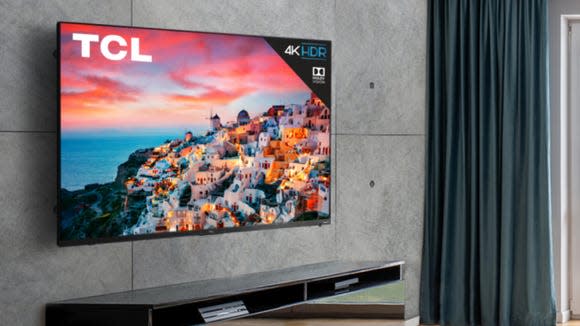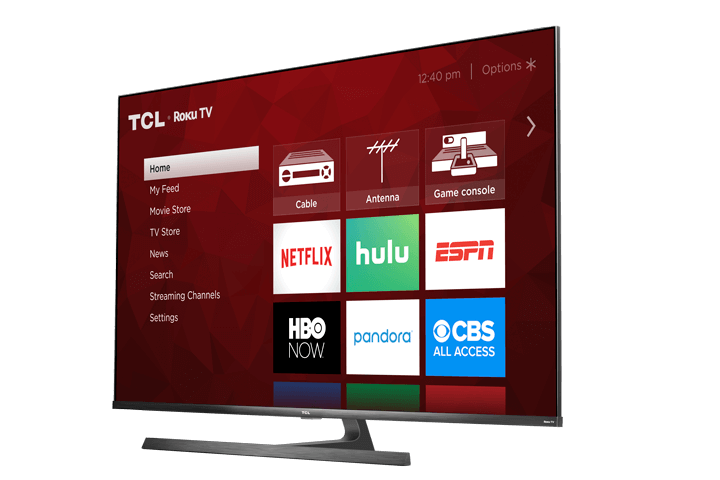Living with TCL's 8-series 4K TV: Quality without paying for OLED
It's especially good if you can get it at a discount.
Every month, Engadget features what our editors are currently into, whether it be video games, podcasts or gadgets. These are not official reviews; they’re simply our first-hand experiences. This week, Senior Editor Devindra Hardawar gives his thoughts on his latest gadget baby, TCL’s 65-inch 8-series TV.
So I needed a bigger TV. A first world problem, I know. But after jumping ship from NYC to an Atlanta suburb (which also led me to buy a car via Carvana), my trustworthy 55-inch LG OLED just felt tiny. It was fine in a cozy Brooklyn apartment, especially since I also had a projector nearby for big-screen viewing. But it just couldn't cut it in a larger living room, where we're sitting twice as far away.
I knew I had to make the jump to a 65-inch set. I also realized I didn't have the budget to get another OLED, especially not when 65-inch QLED sets (TVs with quantum dot LED screens) are typically more than half the price. I'd rather get a larger "good enough" TV for family viewing and save a bit of cash for future gear. At first, I figured I would wait until the inevitable Black Friday sales before upgrading. But then our commerce editor, Valentina Palladino, dug up some fantastic deals for TCL's premium 8-series sets at Best Buy. How could I say no to a $1,000 65-inch TV (down from $2,000!) with some of the latest display technology around?
Over the past decade, TCL rose from a company synonymous with bargain-bin sets to the world's largest TV maker. Its 6-series models have consistently been some of our favorite TVs, thanks to their low starting price and features like Dolby Vision, Roku OS integration and a plethora of local dimming zones (which helps with delivering great contrast and black levels).
Last year, it aimed a bit higher with its 8-series sets, which started at $2,000 and directly targeted the likes of Sony and Samsung. They were among the first TVs to feature mini-LED backlighting, which uses around 25,000 individual lights for more accurate local dimming. (The 2019 6-series, in comparison, offered 120 dimming zones at 65-inches.) Reviewers gushed over the 8-series -- many said it delivered image quality close to what you'd get from OLED. And as its price creeped down, it became an even better deal.

I'm not exactly sure why Best Buy offered the 8-series TVs at a steep discount several times this year (most recently, the massive 75-incher was just $1,500!). Maybe they had to clear out stock to make room for new models. Or maybe it was a way to encourage more sales as people were stuck at home, with nowhere to go. Either way, I'm glad I didn't question myself too much, as the 65-inch 8-series is back up to $1,300 as I'm writing this. (But if you're intrigued, I'm sure it'll pay off to wait for more sales.)
After making a trek to a Best Buy shipping facility to pick it up (which required borrowing my parents large SUV, like the old days), I was able to set up the TV in around 20 minutes. The box was intuitively packed, so it was easy to reach in and find every component and pull the display out. If you've put one large HDTV together, you've pretty much done them all: Lay the screen down flat with a helper (hopefully on a soft surface), install the stand, and pray that nothing goes wrong as you walk it over to your TV stand. (I may just wall-mount it eventually for a cleaner look.)
The 8-series' design is purely utilitarian. The screen itself is boxy and a bit thick (though nothing can compare to OLED's thinness), but I appreciate its minimal side bezels. The metal stand sits in the center, making it feel more sturdy than sets with flimsy legs. While it's not a design statement like a Sony set, the size of the screen alone makes it a commanding presence in my living room. (Honestly, I worried it would be too distracting, but I've since gotten used to it.)
I knew I made the right decision the instant I turned on the TV. Its sheer brightness shocked me at first -- and I was just looking at the Roku OS setup screen. After hooking it up to my Roku account, it downloaded all of my channels. Within a few minutes I was relaxing and catching up on my YouTube subscriptions as usual. After running through some of my favorite HDR demos -- the almost pitch black night-time fight scenes in Netflix's Daredevil, the wondrous colors and variety of landscapes in Planet Earth's 4K Blu-ray -- everything looked phenomenal.

In some instances, like the darkest scenes in Daredevil, it lagged behind the perfect contrast levels of my previous TV. With OLEDs, every pixel can be turned on and off individually, which helps to deliver inky black levels and backlighting far superior to most LCDs. But my OLED set (LG’s B6) is from 2016, and I've begun to notice some image processing issues that would only be fixed by moving up to a more modern set. That's one of the benefits of TCL's 8-series: It has more powerful processing, so it can handle things like grey gradients far better.
Really, I just wanted a bigger TV to make nightly binge-watching feel a bit more cinematic before I start building out a proper home theater in my basement. I didn’t really have to go this hard for a secondary set. But I’m glad I opted for the 8-series instead of a cheaper 65-inch TV. It makes me miss my OLED less, since it’s an improvement in some respects. I also appreciated having Roku OS built in, so I can jump into all of my streaming content without any extra devices. Roku also plans to make its platform more robust later this year with the addition of AirPlay 2 and HomeKit for most of its 4K devices.
The 8-series also has a 120Hz refresh rate, which makes it a good display to have for PC and next-gen console gaming. Earlier this year, TCL announced that it would also add support for variable refresh rates, which will help smooth out gameplay in general. One big downside? There's no HDMI 2.1 support, which means you won't be able to get 4K beyond 60Hz/60 frames per second. That likely won't be a huge deal for the Xbox Series X and PlayStation 5, which are more focused on delivering solid 4K/60FPS performance. And if you want higher refresh rates, you can always limit your resolution to 1080p or 1,440p (PC gamers are already used to sacrificing resolution for silkier framerates).
As an OLED diehard for years, it’s nice to see that quantum dot LEDs are steadily getting better. Their prices are dropping, while OLED still remains out of reach for many consumers. And after living with TCL’s 8 series for a few weeks now, it’s hard for me to recommend spending nearly twice as much money for increasingly minimal gains.

 money
money 